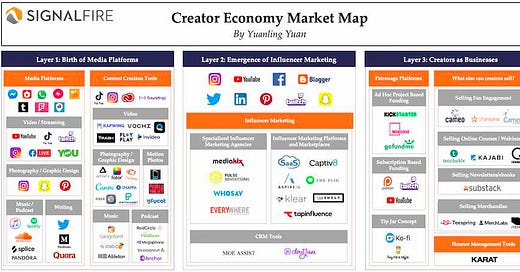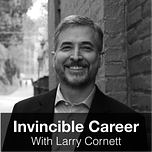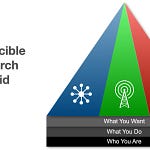
What if I told you that a podcast brings in $2-4M in annual revenue on Patreon? No, that’s not my Patreon page (I wish!).
Did you know that the top streamer on Twitch pulls in over $5M a year?
Yeah, I was surprised too.
Whether you call it the “passion economy” or the “creator economy,” something fascinating is happening for people who crave freedom in their work and lives. More services and platforms have been springing up over the past few years that enable you to make a living simply from who you are and what you can do.
This goes way beyond making money from your voice, which I talked about recently. This is also not about using your talent and skills for an employer, which most of us do — or have done — for most of our working lives.
One example is True Crime Obsessed, a popular podcast that takes a deep dive into longer true-crime docu-series (e.g., Serial, The Staircase, Making a Murderer). They have 38,680 patrons on Patreon. Their tiers range from $5 to $20 per month.
I don’t know their exact monthly subscription revenue (i.e., it isn’t published). Even if everyone is only at the $5 tier, that means they’re generating at least $2,320,800 in annual revenue from their Patreon account.
I’m only using the following to show what is possible with a loyal fan base. Most people won’t achieve the level of income of these top earners. But, I was pleasantly surprised to see many creators earning six figures, which could be enough to make a living (in most places).
All Gas No Brakes shares exclusive interviews on Patreon. They bring in $1,079,040 per year.
Bill Bishop writes the publication Sinocism on Substack. Estimates put his annual revenue from the newsletter at over $1M. Note: the top 10 writers on Substack collectively bring in more than $10 million per year.
Podia is a platform for video courses and digital memberships. The top creator there makes more than $1M a year.
Beardbrand is a merchant on Shopify and grew to $120k in monthly sales in less than one year.
Richard Blevins is a gamer better known as Ninja. He earns $5.4M per year from streaming on Twitch.
There are over 50M content creators in the world. But, there are probably only ~2M that make a living by doing it full time.
What is the Passion Economy?
Our current economy has been based on scale, reach, automation, and deep pockets. Large corporations like Amazon, Google, Netflix, YouTube, and Apple have dominated the marketplace. Walmart, Amazon, Costco, Flipkart, etc., have flooded us with mass-produced goods and competed for our wallets with ever-lower prices.
Massive social media sites like Facebook, Instagram, and Twitter have overwhelmed our attention span and tested our patience with others. More and more people are taking “social media detox” breaks, or delete their accounts entirely. Yet, people have said that they would be interested in a new platform dedicated to one of their personal passions.
Adam Davidson coined the phrase “passion economy” in a book called The Passion Economy. You can think of it as the ultimate “shop small” philosophy.
It’s based on three key components coming together:
Creators who are building a business around a unique talent, skills, ideas, topic, or passion.
Audiences who are interested in the goods, services, or experiences the creators have to offer.
Online platforms that host the creators and their offering and connect them with their audience.
The passion economy is enabled by various digital platforms and services that have been created over the decades (e.g., blogging, messaging, photo and video hosting, podcasting, e-commerce, online payments). In some ways, it feels like a response to the commoditization that has occurred with goods and services — and even employment.
Buyers, audiences, and fans are seeking:
Higher-quality goods they can trust
High-touch personalized services
One-on-one connections with experts
A stronger sense of community
Connecting with people around niche interests
More intimate relationships with fewer people
Unique and interesting experiences
More targeted and valuable information
Creators are seeking:
Freedom from employment in jobs that don’t fulfill them
A chance to live up to their full potential
Fair compensation for their talents, skills, and knowledge
An opportunity to make a living doing what they love
A shot at turning a passion into a way to make a living
How is this different than the gig economy (e.g., Uber, Lyft, Doordash)? With a gig, you provide the service that the platform demands (e.g., giving someone a ride from point A to point B). They set the rules and control pricing. If you want to earn more, you have to hustle faster and work longer hours.
The gig economy is based on convenience, consistency, and competitive pricing. The passion economy rewards individuality, creativity, relationships, and excellence.
With the passion economy, you work for yourself. You decide what you are selling. You set your prices. You decide when you want to “work.”
A very entertaining Uber driver can’t suddenly decide that a ride to the airport is worth $400 because he’s an excellent storyteller. Uber controls the pricing.
But, an artist on Podia can charge whatever she wants for access to a painting lesson. If she’s an amazing artist in high demand, she can charge a lot more than another artist who doesn’t have a fan base.
You will never get rich in the gig economy. But, the passion economy has the potential to make you wealthy if you are damn good at what you do and your fans love you.
What can you sell?
Your imagination is the limit. No, really, it is.
Every day, I come across a new creator that has come up with something I had never considered. Some people are incredibly creative, and I’m always surprised that an audience is hungry for what they have to offer (e.g., “People will pay for that?”).
Here are some simple examples to give you an idea of what you might have to offer:
Your knowledge and advice (e.g., newsletters, articles)
Your words (e.g., short stories, poetry, fiction, nonfiction)
Courses you create
Live courses
Live webinars
Live coaching sessions
Exclusive podcasts
Photography
Videos
Illustrations
Designs
Comics
Watching you play games
Artwork
Pottery
Physical products
Access to you
Access to communities
Music
Monetization models
I’m a little overwhelmed by all of the creative ways people have monetized their personal passion economy “businesses.” You may already be familiar with social media influencers who get paid by sponsors to showcase products to their large audiences of followers. One of the most popular influencers, Kylie Jenner, has an ad equivalent value of $1M+ per post across her social media portfolio.
But, the rest of us mere mortals generate income from sources such as:
Ad revenue sharing
Sponsored content
Affiliate revenue
Tipping
Paid subscriptions
Direct sales of physical and digital goods
Tickets for live and virtual events
VIP meetups
Fan club membership
However, all of this boils down to four primary models:
Subscriptions for access to exclusive content
Freemium with upsells to premium content
Direct sales (e.g., services, digital goods, physical goods, events, experiences)
Ads and Sponsorships
I know that this can seem out of reach if you have a small audience of followers and fans. But, it doesn’t take much to get started with a passion economy business. You can also build your audience on the side while you’re earning income from your primary job.
Kevin Kelly’s famous “1,000 True Fans” concept should give you hope if you’re interested in making a living from your passion, knowledge, and talent.
“To be a successful creator you don’t need millions. You don’t need millions of dollars or millions of customers, millions of clients or millions of fans. To make a living as a craftsperson, photographer, musician, designer, author, animator, app maker, entrepreneur, or inventor you need only thousands of true fans.” — Kevin Kelly
Passion Economy Platforms
Here are just a few of the platforms and service providers that power the passion economy. Some of these are my referral links, so thank you for your support! Check them out if you want to learn more.
Newsletters
Writing
Digital Goods
Music
Physical Goods
Art
Courses
Memberships and Fans
Patreon (BTW, I’m on Patreon if you’re interested)
OnlyFans (No, it isn’t just for that kind of content. Michael B. Jordan said he will be creating an account.)
Entertainment and Video
A new path to freedom
I find all of this very exciting! It gives all of us more flexibility in how we decide to work and live. With a passion economy business — especially one with digital goods and services — you can live anywhere in the world and work whenever you want.
Most of us will follow a traditional career path of climbing the corporate ladder. It can be gratifying and lucrative, as well. I did it for about 17 years, learned a lot, and had many wonderful experiences.
The economy of the past century rewarded fitting in and being what a company wanted. Get your standardized education, put on your professional clothing, land a job in an office, fit into the corporate culture, don’t make too many waves, and you’ll be OK.
But, a better strategy for the economy of the next century is to be you — unashamedly yourself — and capitalize on how different you are from everyone else. Focus on your unique story, your personal brand, how you can stand out, and the personal value that no one else can copy. That’s where future success will lie.
As you know, I also recommend having backup plans and multiple income streams. Owning your income and destiny makes you invincible. It’s wonderful to know that you could ramp up your side hustle to pay the bills if something happened to your primary job (e.g., an unexpected layoff).
You can always test the waters with some of the platforms that I discussed here. If you’re enjoying it and making some money, see where it takes you! That’s how it began for me when I started writing on Medium.
You never know. Some of the more successful creators had no idea that things would turn out so well that they could quit their 9-5 jobs and go all-in on doing something they love.
If you do decide to try it out, let me know! I’d love to support you.
This week’s professional development challenge
⭐ Capture Your Achievements for the Year
Despite all of the uncertainty, chaos, and setbacks, you’re still here and moving ahead. You accomplished more things than you give yourself credit for doing.
Larry Cornett is a leadership coach and business advisor. He lives in Northern California near Lake Tahoe with his wife and children, and a gigantic Great Dane. He does his best to share advice that can help others take full control of their work and life. He’s also on Twitter @cornett.














Share this post